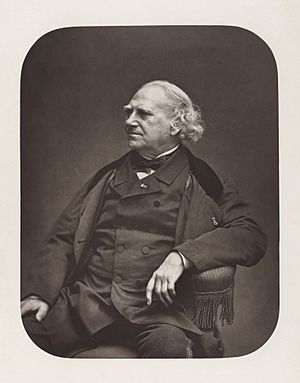Louis Désiré Blanquart-Evrard facts for kids
Quick facts for kids
Louis Désiré Blanquart-Evrard
|
|
|---|---|

Blanquart-Evrard in 1869
|
|
| Born | 2 August 1802 |
| Died | 28 April 1872 (aged 69) Lille, France
|
| Known for | Albumen printing |
Louis Désiré Blanquart-Evrard (born August 2, 1802 – died April 28, 1872) was a French inventor and photographer. He also published many early photographs. Even though he was a cloth merchant, he became very interested in photography in the 1840s. He worked on making it easier and cheaper to print many photos at once.
Biography
Louis Désiré Blanquart-Evrard was born and grew up in Lille, France. He studied chemistry there. He also learned how to paint tiny pictures on porcelain.
In 1839, Louis Daguerre showed the world a new way to take photos called daguerreotypy. This made photography much more practical. Blanquart-Evrard became very interested in this new art.
He then studied the calotype process. This was a way to make photo negatives on paper. In 1847, he was the first person in France to write about how to make photos using paper negatives and positives. He found a better way to prepare the paper. Instead of brushing chemicals on, he dipped the paper in solutions. This helped make the photo prints more stable.
His Photo Printing Company
In 1850, Blanquart-Evrard created a new photo printing method. It was called the albumen paper printing technique. This method became very popular. It was used for small photos known as carte de visite. These were like early trading cards with people's pictures on them.
In September 1851, he started a large printing company in Lille. It was called Imprimerie Photographique de Lille. He opened it with Hippolyte Fockedey. This was one of the first big companies to print many photos. It hired many people.
Blanquart-Évrard helped show the work of many important early photographers. These included Charles Marville and Maxime Du Camp. He also published famous photos of the Pyrenees mountains and Jerusalem.
However, the calotype process he used had some problems. It often left the sky looking plain white. It also made the front of the picture look too dark. To fix this, artists sometimes added clouds from other negatives. But sometimes the clouds were taken in the morning and the main picture in the afternoon! Also, early photo prints would fade over time. Because of these issues, Blanquart-Evrard's company closed in 1855. It couldn't compete with other printing methods like lithographs.
His Legacy
In the 1860s, Blanquart-Evrard wrote several important books. One was called La photographie: ses origines, ses progrès, ses transformations. In this book, he wrote about the first thirty years of photography. He also shared important ideas about photography as an art form.
Today, he is seen as a very important person from the 1850s. This time is often called a golden decade for how much photography grew and improved.
See also
 In Spanish: Louis Désiré Blanquart-Evrard para niños
In Spanish: Louis Désiré Blanquart-Evrard para niños

